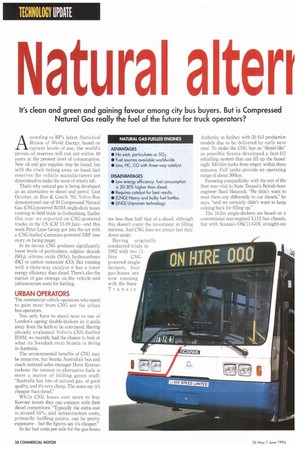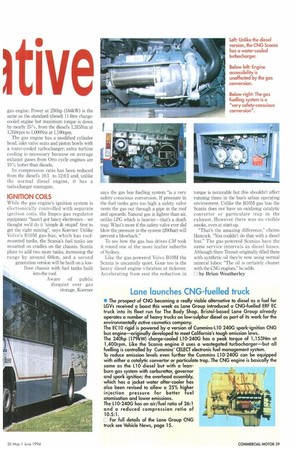Natural alter! Itive
Page 40

Page 41

If you've noticed an error in this article please click here to report it so we can fix it.
It's clean and green and gaining favour among city bus buyers. But is Compressed Natural Gas really the fuel of the future for truck operators?
According to BP's latest Statistical Review of World Energy, based on current levels of use, the world's proven oil reserves will run out within 40 years at the present level of consumption. New oil and gas supplies may be found, but with the clock ticking away on fossil fuel reserves the vehicle manufacturers are determined to make the most of what's left.
That's why natural gas is being developed as an alternative to diesel and petrol. Last October, at Bus & Coach '93, Volvo Bus demonstrated one of 20 Compressed Natural Gas (CNG)-powered BlOM single-deck buses running in field trials in Gothenburg. Earlier this year we reported on CNG-powered trucks in the US (CM 13-19 Jan)—and this week Peter Lane Group got into the act with a CNG-fuelled Cummins-powered ERF (see story on facing page).
In its favour, CNG produces significantly lower levels of particulates, sulphur dioxide (502), nitrous oxide (N0x), hydrocarbons (HC) or carbon monoxide (CO). But running with a three-way catalyst it has a lower energy efficiency than diesel. There's also the matter of gas storage on the vehicle and infrastructure costs for fuelling.
URBAN OPERATORS
The commercial vehicle operators who stand to gain most from CNG are the urban bus operators, You only have to stand next to one of London's ageing double-deckers as it pulls away from the kerb to be convinced_ Having already evaluated Volvo's CNG-fuelled BlOM, we recently had the chance to look at what its Swedish rival Scania is doing in Australia.
The environmental benefits of CNG may be attractive, but Scania Australia's bus and coach national sales manager Horst Koerner reckons the interest in alternative fuels is more a matter of folding green stuff: "Australia has lots of natural gas, of good quality, and it's very cheap. The sums say it's cheaper than diesel."
While CNG buses cost more to buy Koerner insists they can compete with their diesel competitors: "Typically the extra cost is around 10%, and infrastructure costs, primarily fuelling points, can be pretty expensive -but the figures say it's cheaper."
So far fuel costs per mile for the gas buses are less than half that of a diesel, although this doesn't count the investment in filling stations. And CNG does not attract fuel duty down under.
Having originally conducted trials in 1992 with two 11
litre CNGpowered singledeckers, four gas-buses are now running with the State Transit
Authority in Sydney with 50 full production models due to be delivered by early next year. To make the CNG bus as "diesel-like" as possible Scania developed a fast-fill refuelling system that can fill up the buses' eight 100-litre tanks from empty within three minutes. Full ranks provide an operating range of about 300km.
Ensuring compatibility with the rest of the fleet was vital to State Transit's British-born engineer Basil Hancock: "We didn't want to treat them any differently to our diesels," he says, "and we certainly didn't want to keep coming back for filling up."
The 10.5m single-deckers are based on a conventional rear-engined L113 bus chassis, but with Scania's OSC11-G01 straight-six gas engine. Power at 250hp (184kVii) is the same as the standard (diesel) 11-litre chargecooled engine but maximum torque is down by nearly 25%, from the diesel's 1,315Nm at 1,350rpm to 1,000Nm at 1,100rpm.
The gas engine has a modified cylinder head, inlet valve seats and piston bowls with a water-cooled turbocharger; extra turbine cooling is necessary because on average exhaust gases from Otto cycle engines are 10% hotter than diesels.
Its compression ratio has been reduced from the diesel's 16:1 to 12.6:1 and, unlike the normal diesel engine, it has a turbocharger wastegate.
IGNITION COILS
While the gas engine's ignition system is electronically controlled with separate ignition coils, the lmpco gas regulator equipment "hasn't got fancy electronics --we thought we'd do it 'simple & stupid' first to get the right mixing", says Koerner. Unlike Volvo's MOM gas-bus, which has roofmounted tanks, the Scania's fuel tanks are mounted on cradles on the chassis. Scania plans to add two more tanks, increasing the range by around 60km, and a second generation version will be built on a lowfloor chassis with fuel tanks built into the roof.
Aware of public disquiet over gas storage, Koerner says the gas bus fuelling system "Ls a very safety-conscious conversion. If pressure in the fuel tanks gets too high a safety valve vents the gas out through a pipe in the roof and upwards. Natural gas is lighter than air, unlike LPG which is heavier—that's a death trap. What's more if the safety-valve ever did blow the pressure in the system (200bar) will prevent a blowback."
To see how the gas bus drives CM took it round one of the more leafier suburbs of Sydney.
Like the gas-powered Volvo BlOM the Scania is uncannily quiet. Gone too is the heavy diesel engine vibration at tickover. Accelerating from rest the reduction in torque is noticeable but this shouldn't affect running times in the bus's urban operating environment. Unlike the BlOM gas bus the Scania does not have an oxidising catalytic convertor or particulate trap in the exhaust. However there was no visible smoke, even at start-up.
"That's the amazing difference," claims Hancock. "You couldn't do that with a diesel bus." The gas-powered Scanias have the same service intervals as diesel buses. Although State Transit originally filled them with synthetic oil they're now using normal mineral lubes: "The oil is certainly cleaner with the CNG engines," he adds.
El by Brian Weatherley
























































































